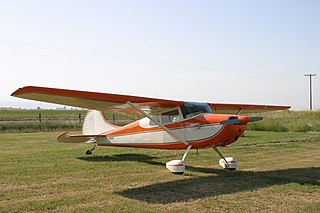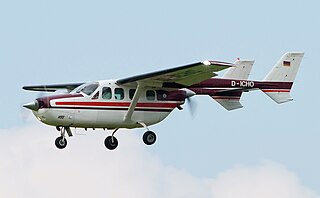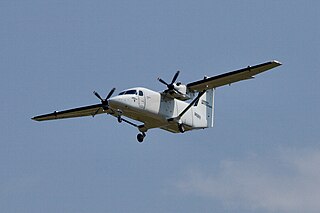Related Research Articles

The Cessna 172 Skyhawk is an American four-seat, single-engine, high wing, fixed-wing aircraft made by the Cessna Aircraft Company. First flown in 1955, more 172s have been built than any other aircraft. It was developed from the 1948 Cessna 170 but with tricycle landing gear rather than conventional landing gear. The Skyhawk name was originally used for a trim package, but was later applied to all standard-production 172 aircraft, while some upgraded versions were marketed as the Cutlass, Powermatic, and Hawk XP. The aircraft was also produced under license in France by Reims Aviation, which marketed upgraded versions as the Reims Rocket.

The Cessna 152 is an American two-seat, fixed-tricycle-gear, general aviation airplane, used primarily for flight training and personal use. It was based on the earlier Cessna 150 incorporating a number of minor design changes and a slightly more powerful engine with a longer time between overhaul.

The Cessna 208 Caravan is a utility aircraft produced by Cessna. The project was commenced on November 20, 1981, and the prototype first flew on December 9, 1982. The production model was certified by the FAA in October 1984 and its Cargomaster freighter variant was developed for FedEx. The 4 ft (1.2 m) longer 208B Super Cargomaster first flew in 1986 and was developed into the passenger 208B Grand Caravan.

The Cessna 170 is an American single-engine, four seat, general aviation aircraft produced by the Cessna Aircraft Company between 1948 and 1956.

The Cessna O-1 Bird Dog is a liaison and observation aircraft that first flew on December 14, 1949, and entered service in 1950 as the L-19 in the Korean War. It went to serve in many branches of the U.S. Armed Forces, was not retired until the 1970s in a number of variants, and also served in the Vietnam War. It was also called the OE-1 and OE-2 in Navy service, flying with the Marine Corps, and in the 1960s it was re-designated the O-1. It remains a civilian-flown warbird aircraft, and there are examples in aviation museums. It was the first all-metal fixed-wing aircraft ordered for and by the United States Army following the Army Air Forces' separation from it in 1947. The Bird Dog had a lengthy career in the U.S. military as well as in other countries, with over 3400 produced.

The Cessna 150 is a two-seat tricycle gear general aviation airplane that was designed for flight training, touring and personal use. In 1977, it was succeeded in production by the Cessna 152, a minor modification to the original design.

The Cessna Skymaster is an American twin-engine civil utility aircraft built in a push-pull configuration. Its engines are mounted in the nose and rear of its pod-style fuselage. Twin booms extend aft of the wings to the vertical stabilizers, with the rear engine between them. The horizontal stabilizer is aft of the pusher propeller, mounted between and connecting the two booms. The combined tractor and pusher engines produce centerline thrust and a unique sound. The Cessna O-2 Skymaster is a military version of the Cessna Model 337 Super Skymaster.

The Beechcraft Bonanza is an American general aviation aircraft introduced in 1947 by Beech Aircraft Corporation of Wichita, Kansas. The six-seater, single-engined aircraft is still produced by Beechcraft and has been in continuous production longer than any other aircraft in history. More than 17,000 Bonanzas of all variants have been built, produced in both distinctive V-tail and conventional tail configurations; early conventional-tail versions were marketed as the Debonair.

The Cessna 180 Skywagon is a four- or six-seat, fixed conventional gear general aviation airplane which was produced between 1953 and 1981. Though the design is no longer in production, many of these aircraft are still in use as personal aircraft and in utility roles such as bush flying.

The Cessna 205, 206 and 207, known primarily as the Stationair, are a family of single-engined, general aviation aircraft with fixed landing gear, used in commercial air service as well as for personal use. The family was originally developed from the popular retractable-gear Cessna 210 and produced by the Cessna Aircraft Company.

The Cessna 401 and 402 are a series of 6 to 10 seat, light twin-piston engine aircraft. All seats are easily removable so that the aircraft can be used in an all-cargo configuration. Neither the Cessna 401 nor the 402 were pressurized, nor were they particularly fast for the installed power. Instead, Cessna intended them to be inexpensive to purchase and operate.

The Cessna 177 Cardinal is a light single-engine, high-wing general aviation aircraft produced by Cessna. It was intended to replace the Cessna 172 Skyhawk. First announced in 1967, it was produced from 1968 to 1978.

The Cessna 210 Centurion is a six-seat, high-performance, retractable-gear, single-engined, high-wing general-aviation light aircraft. First flown in January 1957, it was produced by Cessna until 1986.

The Cessna 421 Golden Eagle is an American six or seven seat twin-engined light transport aircraft, developed in the 1960s by Cessna as a pressurized version of the earlier Cessna 411.

The Cessna 414 is an American light, pressurized, twin-engine transport aircraft built by Cessna. It first flew in 1968 and an improved variant was introduced from 1978 as the 414A Chancellor.

The Cessna 190 and 195 Businessliner are a family of light single radial engine powered, conventional landing gear equipped, general aviation aircraft which were manufactured by Cessna between 1947 and 1954.

The Cessna Airmaster, is a family of single-engined aircraft manufactured by the Cessna Aircraft Company. The Airmaster played an important role in the revitalization of Cessna in the 1930s after the crash of the aviation industry during the Great Depression.

The Cessna Model 411 is an American twin-engined, propeller-driven, non-pressurized light aircraft built by Cessna Aircraft. It was that company's largest business aircraft to enter production when it first flew in 1962.

The Champion 402 Lancer is a twin-engine trainer produced by Champion Aircraft, a high-wing monoplane based on the tricycle gear Champion 7FC Tri-Traveler, but with wing-mounted Continental O-200-A engines. The Lancer first flew in 1961 and production began in 1963. The Lancer seats two in a tandem configuration with dual flight controls; the pilot in command or student pilot normally occupies the front seat.

The Cessna 408 SkyCourier is an American utility aircraft designed and built by the Cessna division of Textron Aviation. It was launched on November 28, 2017, with an order for 50 from FedEx Express, with the aircraft designed for the needs of its FedEx Feeder service. It made its first flight on May 17, 2020, and was type certified on March 11, 2022. FedEx took delivery of the first production model on May 9, 2022.
References
- 1 2 "N-Number Inquiry Results: N41695". Federal Aviation Administration . Retrieved June 8, 2024.
- 1 2 Murphy, Daryl (2006). "The Cessnas that got away". Archived from the original on February 9, 2013. Retrieved November 5, 2024.
- 1 2 Phillips, Edward H: Wings of Cessna, Model 120 to the Citation III, Flying Books, 1986. ISBN 0-911139-05-2
- 1 2 Simpson, R.W. (1995). Airlife's General Aviation (2nd ed.). Airlife Publishing. ISBN 1853105775.